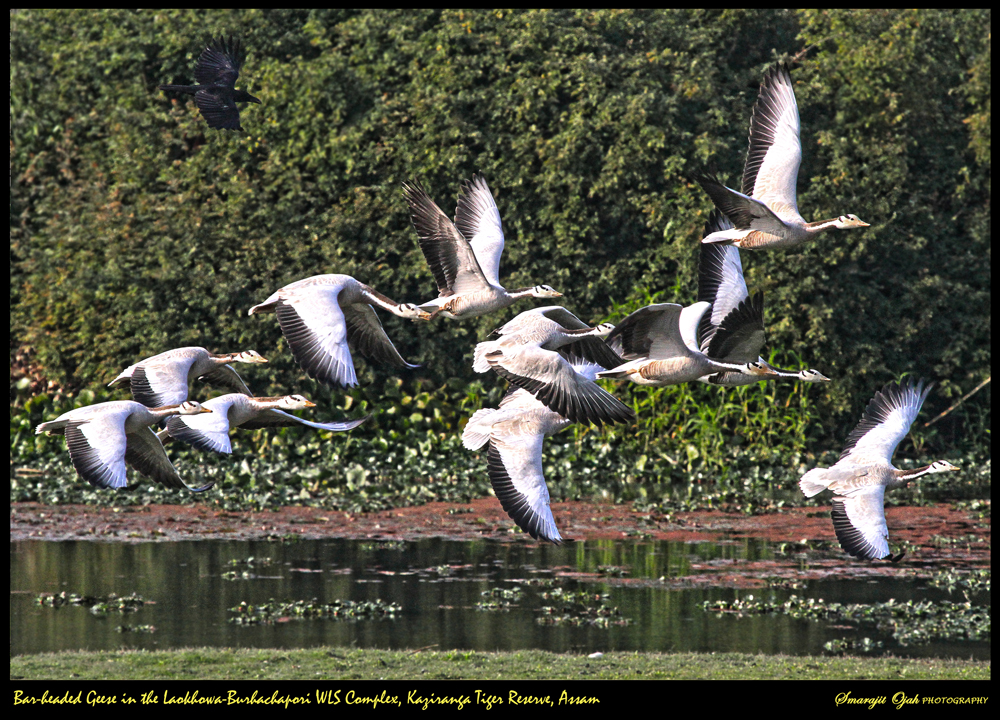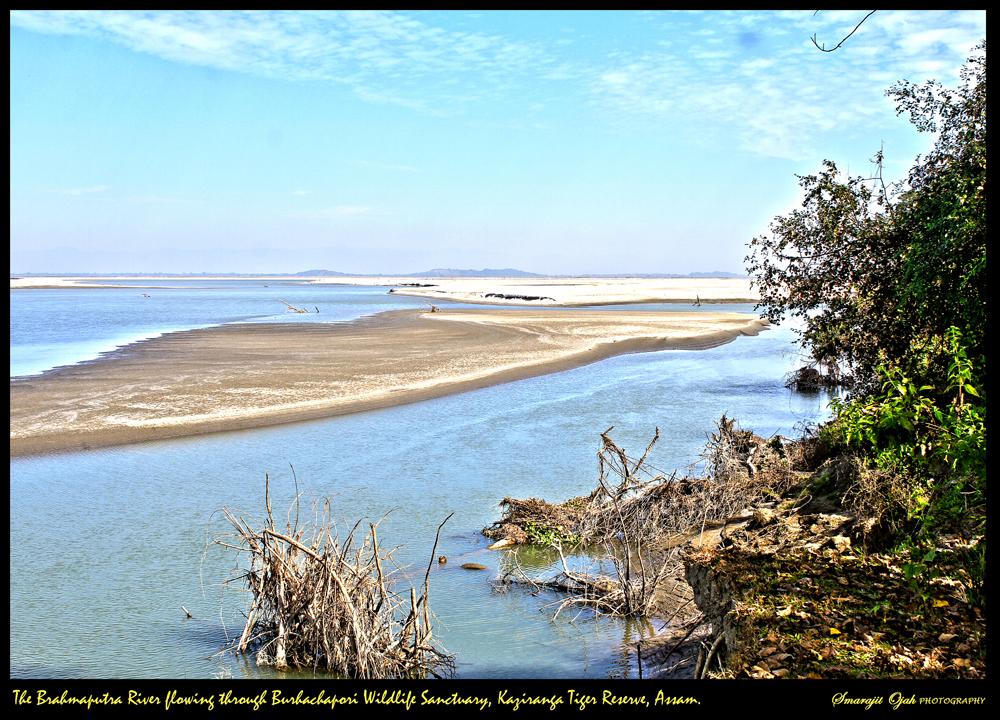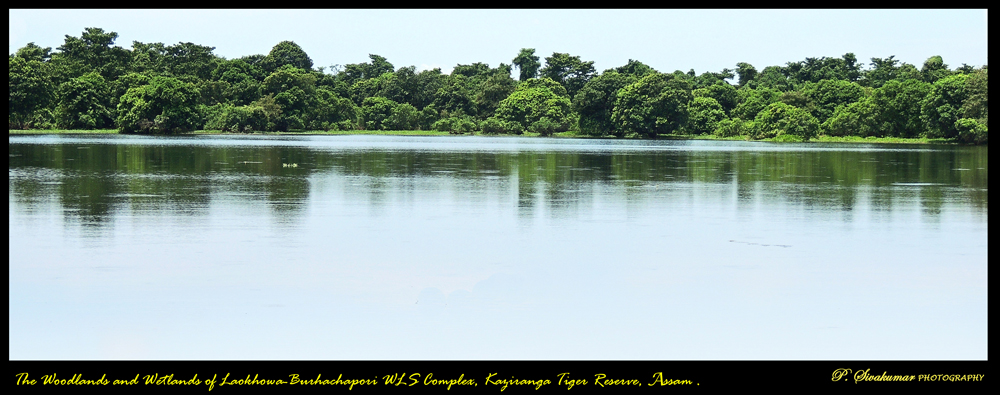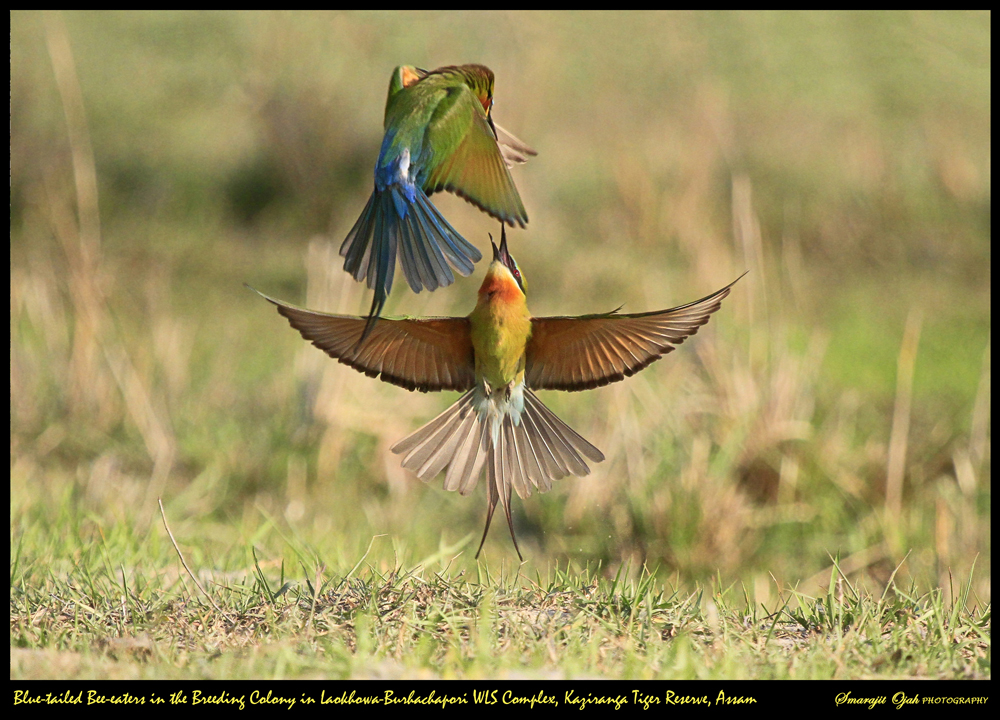Laokhowa Wildlife Sanctuary covers an area of around 70.13 sq km and lies on the southern bank of the Brahmaputra River. It forms an integral part of the Laokhowa-Burachapori eco-system and is a notified buffer of the Kazairanga Tiger reserve.The sanctuary is home to the great Indian-one horned rhinoceros, elephants, royal Bengal tigers, Asiatic water buffaloes and more than 225 species of birds.
The barking deer, fishing cat, leopard cat, civet and wild pig are some of the other animals seen in the sanctuary. The sanctuary is also a breeding ground for around 39 species of fishes, 9 species of amphibians and 14 species of reptiles.
ABOUT LAOKHOWA-BURACHAPORI WILDLIFE SANCTUARYs :
The Laokhowa and Burhachapori Wildlife Sanctuaries are two centrally located Protected Areas of Assam, surrounded by many key PAs like Kaziranga National Park to the east, Orang National park and Pobitora Wildlife sanctuaries to the west, Pakke-Nameri NPs to the north and the rich reserve Forests of Karbi Anglong to the south. The PAs act as connecting corridor for migration of animals between Kaziranga and Orang National parks and hence, has been identified as Buffer Zones of Kaziranga Tiger Reserve. The mighty Brahmaputra River flows through the northern boundary of the Burhachapori Wildlife Sanctuaries creating a large number of river islands. The rich ecosystem of the Laokhowa Burhachapori characterized by grasslands, woodlands and numerous wetlands along with the Brahmaputra River Islands are home to numerous species of endangered mammals, reptiles and birds.
ECOLOGY OF LAOKHOWA-BURACHAPORI
The Laokhowa and Burhachapori Wildlife Sanctuaries are two highly significant ecosystems of the state of Assam. The PAs were historically been ideal home for various key species of endangered mammals, reptiles and birds. Large mammals like Asiatic water Buffalo, Royal Bengal Tiger and Elephants etc. are still found in these two sanctuaries. Besides, Rhinos migrating among the Kaziranga and Orang National Park and Pobitora Wildlife sanctuaries have been spotted in the Laokhowa and Burhachapori Wildlife Sanctuaries from time to time. In addition to that, wet alluvial grassland sustain a large number of herbivores like sambar, barking deer and hog deer along with nocturnal species like pangolins, slow loris, porcupine and hare etc. Many rare and endangered species (many of them coming under the Schedule I species category under the Wildlife Protection Act. 1972) of small cats, civets and otters, reptiles like pythons, common and water monitor, turtles like Assam Roofed, Indian Roofed, Peacock Softshelled, Soft shelled Turtles, Butterflies like Birdwing, Common Map, Crimson Rose etc. are still found in abundance in these two PAs. The numerous natural and perennial wetlands are functioning as breeding ground for various kinds of local fish species and highly important bird species such as Storks like Adjutant, Lesser Adjutant, White Stork, Black Necked Stork, Black Stork besides birds like Large Whistling Teal, Herons, various kinds of Raptors, numerous grassland birds including highly endangered Bengal Florican. Many species of migratory birds, including water fowls, visit the rich wetlands of the two PAs every winter. There are records of large flocks of vultures visiting the sanctuaries to feast on the deceased animal remains. The highly endangered Gangetic River Dolphins are still seen in the waters of the Brahmaputra River adjacent to the Burhachapori Wildlife Sanctuaries

ACTIVITIES AT LAOKHOWA-BURACHAPORI WLS
BIRD & BUTTERFLY WATCHING: The landscape of Laokhowa Burhachapori, characterized by numerous wetlands, grassland as well as extensive woodlands besides the Brahmaputra River, is home to a large variety of local and seasonal migratory bird species making the area ideal for observation and documentation of these bird and butterflies.
NATURE TRAIL & TREKKING: The diverse landscape of Laokhowa-Burachapori offers ample scope for undertaking Nature Trails and Treks. The Nature Trails and Trekking Routes start from the Dhania Range Office of Burachapori WLS and runs towards Thulomukoli area through the unique Hijol tree vegetation. The trail then proceeds of the grasslands of Koroitaliwhere one can observe the large and unique colony of Bee-Eater bird in the sandy soils along with other grassland birds, snakes, monitors and mammals besides many varieties of orchids. The trek then enters the Jhaoni region and approaches the Brahmaputra River where numerous riverine local and seasonal migratory bird species, turtles, Gangetic Dolphins may be spotted. As the trek approaches the Basabari area, the landscape changes into thick woodland vegetation and the Laokhowasuti, which runs as a common border of Laokhowa &Burhachapori can be seen. The trek culminates at this point and returns to Dhania.
RIVER AND BEACH TOURISM: The Brahmaputra River flows along the north of Burachapori WLS.
The river is dotted by numerous sandy river islands. There is a houseboat available with the Burhacapori WLS which can be used by tourists to visit the sandy islands where one can entertain themselves by indulging in beachsports and other such activities. The scenic beauty of the landscape and the glorious sunsets can be enjoyed by the tourists.
PHOTOGRAPHY: The diverse landscape of Laokhowa-Burhachaporicharacterized by the scenic beauty and the flora and fauna of the region offers ample scope for photography.

Study Tours, Excursion and Research Activities: The central location of Laokhowa-Burhachapori in the Protected Area Network of the region makes it critical for adoption of a landscape-based conservation approach in Assam. The recent inclusion of the PAs under the Kaziranga Tiger Reserve and the rich biodiversity and ecology of the landscape makes it ideal for undertaking study tours, excursion trips and research activities.
TOTAL AREA OF LAOKHOWA-BURHACHAPORI WLs:
Laokhowa WLS : 70.13 sq. km. Burhachapori WLS : 44.06 sq. km.
HOW TO REACH:
Airport: Guwahati (120 km), Tezpur (68 km), Jorhat (186 km), Railway Station: Haiborgaon (1 km), Chaparmukh (30 km), Guwahati (120 km), By Road: Regular bus service are available from all cities and towns to Nagaon. The NH 36 & 37 passes right through the heart of Nagaon town. (all distances are to Nagaon town). The Nagaon Wildlife Division is located at Katimari, Nagaon at a distance of 2.5 kms from Nagaon town. Burhachapori WLS can also be reached from Tezpur town via Naltoli (NH 37 A). Bus services are available to Laokhowa (28 km), Lailuri (25 km), Singimari (20 km), Sutirpar (26 km) and other important places from Nagaon.
SEASON FOR VISIT:
Tourists can visit the WLSs between 1st November to 30th April.
GUIDELINES FOR ECO-TOURISTS:
Please obtain entry permits from the Nagaon Wildlife Division or the Range Offices of Laokhowa-Burhachapori WLs before entering.
FOOD & ACCOMODATION:
Several Hotels, lodges and resorts, owned by government and private groups are available in Nagaon, Kaliabor and Tezpur towns. Visitors can bring their own food. Eco-Tourists who are interested to eat food cooked by the local communities can provide prior information and order the food during booking of the trips.
CONTACT DETAILS:
Nagaon Wildlife Division, Katimari, Nagaon, Assam (782001)
Ph: 03672-225632
Range Office, Dhania, Burhachapori WLS, Sonitpur, Assam
Range Office, Gorajan, Laokhowa, Nagaon, Assam




Other Accomodation details:
Prashaanti Tourist Lodge Nagaon , MC Borah Road, Nagaon Assam Ph: (0367)2236446
Borduwa Guest House,PO Borduwa,Nagaon (Assam)
Downtown Holiday Resort,Samuguri Beelpar, Nagaon,Ph (03672) 229812, 9954250621
GL Resort,Phulaguri ( Near Borapahar),Kaziranga Bagari Range,Ph: (03776) 279116,/279002,
Diffolu Resort, Bagori (Kazaringa National Park),Ph: 9209200013
Jasingfa Resort,Dimoruguri,Nagaon.
OFFICE ADDRESS
Office of the Tourist Information Officer Prashaanti Tourist Lodge Nagaon
MC Borah Road, Nagaon
Assam
Ph: (0367)2236446
